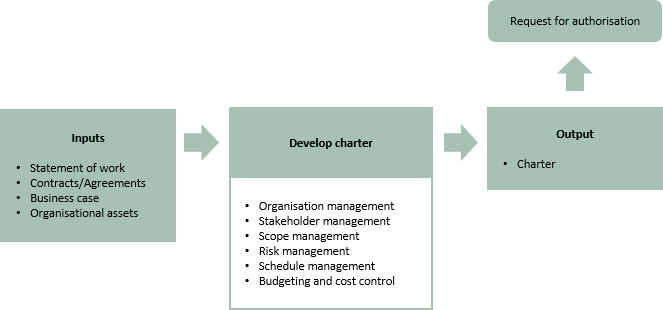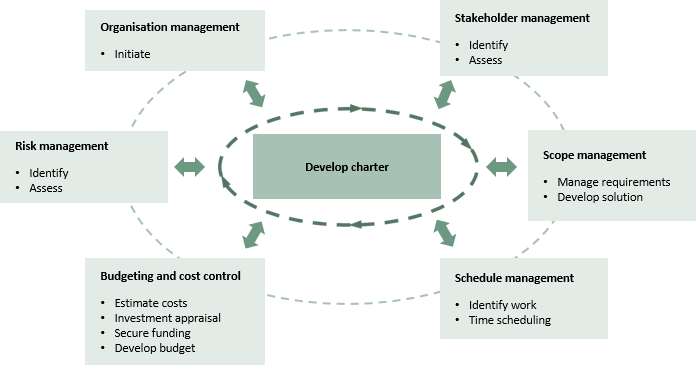General
This process manages the initiation phase of the project or programme life cycle. Its goals are to:
- identify a project or programme manager and define the role;
- document the business need, objectives and high level plans;
- validate the work against organisational strategy;
- gain formal authorisation for the manager to commit resources.
The initial idea for a project or programme can come from a variety of sources. The person or group originating the idea will usually become the owner or sponsor.
The term ‘owner’ is typically used where the originating organisation and delivery organisation are separate entities (e.g. when a property developer contracts with a construction company to develop an office block). In this case the delivery organisation may also have an internal sponsor.
The term ‘sponsor’ is typically used where the originator and delivery team are part of the same organisation.
Before the work is officially recognised and authorised as a project or programme, the originator must develop a statement of work and a business case. This requires the originating organisation to possess the relevant skills – particularly in the areas of requirements management and business case management (including investment appraisal).
If the charter is being prepared for a project within a programme it makes perfect sense for the programme management team to develop the business case and statement of work. They will have the skills to do this and a full understanding of the context of the project within the programme. The same could be said of a charter that covers a stage within a large project.
If the charter relates to an internal, stand-alone project then the host organisation will need scope definition and business case skills to provide the inputs to this process. Those skills are most likely to be possessed by project and programme staff so they may well be involved before this process starts.
In a contracting situation the owner organisation will need to buy in professional skills if they do not exist in-house.
Click on the diagram below for explanations of inputs, the process and outputs

A manager (e.g. a project manager), possibly supported by a small initiation team, should be appointed during this process in order to create the charter. Ownership of the document remains with the owner/sponsor who must provide guidance and give final authorisation.
Since the owner/sponsor is closely involved with the preparation of the document, the final ‘request for authorisation’ should be a formality.
The activities performed by the sponsor/owner are referred to in Praxis as sponsorship. Therefore, for simplicity, the role will be referred to simply as ‘the sponsor’ from this point.
Inputs
- Statement of work
-
The statement of work can take different forms depending on the context of the work. For example, it may be received from a customer as part of a bid document or contract, in which case its format will depend upon the nature of the work (e.g. construction, aerospace, IT, telecoms etc.).
-
An internal statement of work must address three areas: the business need, a description of the objectives (and how they relate to the business need) and an explanation of how the objectives further the host-organisation’s strategic plans.
- Contracts/Agreements
-
If the work is part of a customer/contractor arrangement then a form of contract should be supplied so that the charter is consistent with the terms of the contract.
-
Internal customers may also work with service level agreements that govern the way work will be performed or delivered.
-
In instances where work is conducted in a regulated environment, some form of ‘agreement’ may be relevant as they govern the way the project or programme and its outputs are produced and utilised.
- Business case
-
The business case that is provided as an input to this process is unlikely to contain significant levels of detail. The planning done as part of the develop charter process will provide additional information to help establish whether the business case is viable, desirable and achievable.
-
Even after the charter has been developed and approved there will be a need for more detailed planning which will enable further refinement of the business case. All business cases evolve as more information becomes available. They should be regularly reviewed to ensure they remain viable, desirable and achievable.
-
See business case management for more detail on this key document.
- Organisational assets
-
Any organisation that performs projects and programmes on a regular basis should have assets that support management in a variety of ways. This could include things like policies on how functions are managed, document templates, a knowledgebase of lessons learned, standard software tools, etc.
-
If the charter is for a tranche of a programme or stage of a project, the assets will include relevant information from previous tranches and stages that help develop high level plans for the next tranche or stage.
Back to develop charter process diagram
Functions
The develop charter process co-ordinates activity in various functions in order to produce a charter that brings all the elements together in a coherent high level view of the project or programme. It utilises particular steps from the functional procedures as shown in the diagram below.
Click here to see how the Praxis functions map to the detailed ISO21500 processes.
The first point to note is that, with the exception of organisation management, the plan and initiate steps of the various procedures are not used at this point in the life cycle. This is because the charter is aimed at deciding whether to commit to the project or programme – not to actually start the work.
Planning how these functions will operate and initiating the means of performing them will take place in the next process (develop plans) provided the charter has been authorised by the sponsor.
Click on the diagram below to see more information about each function

- Organisation management
-
The beginnings of a management organisation are built in this process. This may range from simply the manager and sponsor to a broader organisation with specialists in position for functions such as stakeholder management or developing budgets. The scale of the organisation depends entirely on the scale and complexity of the work that is being outlined in the charter.
- Stakeholder management
-
The charter should include a list of key stakeholders and it makes sense to assess their interest and influence on the project or programme at this early stage.
- Scope management
-
Some requirements management and solutions development will have been done to create the statement of work prior to the inception of the develop charter process. This work will be further developed by clarifying requirements and confirming the preferred solution with the relevant key stakeholders.
-
The level of scope definition required is consistent with being able to develop an outline schedule and budget.
- Schedule management
-
The work required to deliver the preferred solution will be identified at a level sufficient to produce a summary milestone schedule. It must be recognised that this is a high level schedule based on high level scope and is therefore, subject to change.
-
For the purpose of allowing an informed decision to be made when considering the charter for approval, confidence levels in the estimates should be given. The thinking behind these confidence levels may well be explained by the high level risks identified.
- Budgeting and cost control
-
Costs should be estimated based on the high level scope. Management reserves may be added to account for the inevitable levels of uncertainty in these early estimates and establish an outline budget.
-
Some investment appraisal will be necessary in order to develop an outline business case and the availability of funding confirmed in principle.
- Risk management
-
The charter should include a list of key risks and it makes sense to assess their probability and impact on the project or programme at this early stage.
Back to develop charter process diagram
Output
The output of this process is the charter – whether it be for a programme, tranche, project or stage. The charter must be submitted for authorisation before the next process develop plans can be undertaken.
A common question about the charter is “how much detail should be included?” The simple answer to this is “enough to enable the approval decision to be made”.
There are other documents that will be created during this process through the functions that it co-ordinates. By invoking the risk management procedure and the stakeholder management procedure the risk register and stakeholder register will be created ready to be extended and enhanced in later processes.
Back to develop charter process diagram
Projects and programmes
On small projects or stages, the development of the charter may be managed and performed by one person but the combination of a separate sponsor and manager is the minimum requirement. It may also be possible to combine the develop charter and develop plans processes into a single process.
In all but the simplest of projects the development of the charter should be a separate phase with a review, and approval of the charter, before proceeding to the development of full plans. In this situation the work will probably require input from specialists who collectively form the initiation team.
Performing this high level analysis can avoid the cost of substantial work in developing detailed plans if the charter doesn’t indicate that sufficient benefits are likely.
Where a project is part of a programme, the charter could be prepared by the programme management team and the develop charter process is bypassed at the project level. The same could be true of a programme that is part of a portfolio. On large, complex projects and programmes, the development of the charter may constitute a small project in its own right.
On larger projects and all programmes, in which the develop plans process will be extensive, it is advisable to accompany the charter with an estimate of the costs and timescale of producing the full plans. This will be important information for the person who is giving approval to proceed.





